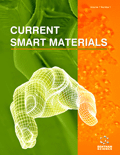Abstract
In the last few decades, as an understanding of polymers grew, their applications in healthcare gained prominence. However, their widespread use was limited due to inevitable ageing, unavoidable degradation and excessive wear and tear. In order to overcome this drawback, researchers took inspiration from the capability of the human body to heal itself. Scientific curiosity and focussed efforts in this direction have laid the foundation for the successful conceptualization of selfhealing polymeric biomaterials and their commercial utilization for ancillary purposes. This review familiarizes the readers with recent literature in self-healing polymers, their fabrication techniques as well as applications in medical and pharmaceutical arenas. It is heartening to note that these polymeric materials have overcome the disadvantages of conventional polymers and shown immense promise in breakthrough technologies such as tissue engineering, anti-biofouling as well as 3D and 4D printing. Self-healing polymers are poised to become critical supporting biomaterials in traditional disciplines such as orthopaedics, dentistry and pharmaceutical drug delivery. Efforts are on to design novel self-healing materials that meet the regulatory requirements of safety and biocompatibility. Research trends indicate that self-healing polymers may play a pivotal supporting role in furthering advances in therapeutics. The authors have, through this review, attempted to spark interest and stimulate creative minds to work in this domain.
Keywords: 4D printing, anti-fouling, bioink, glass ionomer cement, hyaluronic acid, polycaprolactone, scaffolds, self-healing hydrogel, superparamagnetic iron oxide nanoparticles.
Graphical Abstract
[http://dx.doi.org/10.2174/1381612825999191011105148] [PMID: 31604409]
[http://dx.doi.org/10.1007/978-1-4615-2447-2_47]
[http://dx.doi.org/10.3109/21691401.2016.1146731 ] [PMID: 26923861]
[http://dx.doi.org/10.1002/mabi.201100466] [PMID: 22396193]
[http://dx.doi.org/10.1016/B978-0-08-100970-3.00001-8]
[http://dx.doi.org/10.1016/0142-9612(96)85755-3] [PMID: 8624387]
[http://dx.doi.org/10.1016/j.biotechadv.2007.12.005 ] [PMID: 18337047]
[http://dx.doi.org/10.1016/j.chemosphere.2008.06.064 ] [PMID: 18723204]
[http://dx.doi.org/10.1186/2193-1801-2-398] [PMID: 25674392]
[http://dx.doi.org/10.17485/ijst/2011/v4i11.23]
[http://dx.doi.org/10.1088/1748-3182/2/1/P01] [PMID: 17671320]
[http://dx.doi.org/10.1557/mrs2008.158]
[http://dx.doi.org/10.3762/bjnano.9.85] [PMID: 29600152]
[http://dx.doi.org/10.1063/1.328526]
[http://dx.doi.org/10.1016/0263-8223(96)00033-5]
[http://dx.doi.org/10.1038/35057232] [PMID: 11236987]
[http://dx.doi.org/10.3390/ma6062182] [PMID: 28809268]
[http://dx.doi.org/10.1016/j.compositesb.2015.09.057]
[http://dx.doi.org/10.1002/adma.201601613] [PMID: 27488822]
[http://dx.doi.org/10.1002/adma.201003036] [PMID: 20839257]
[http://dx.doi.org/10.1007/978-1-4614-0926-7_12]
[http://dx.doi.org/10.1002/anie.201500484] [PMID: 26216654]
[http://dx.doi.org/10.1155/2012/854203]
[http://dx.doi.org/10.1098/rsif.2007.1022] [PMID: 17426011]
[http://dx.doi.org/10.1088/1757-899X/346/1/012011]
[http://dx.doi.org/10.1186/s40580-019-0199-9] [PMID: 31414249]
[http://dx.doi.org/10.1186/s40580-019-0195-0] [PMID: 31367883]
[http://dx.doi.org/10.1126/sciadv.aay7735]
[http://dx.doi.org/10.1098/rsif.2006.0199] [PMID: 17251129]
[http://dx.doi.org/10.3109/02652040309178083] [PMID: 14594661]
[http://dx.doi.org/10.1080/15583724.2015.1107098]
[http://dx.doi.org/10.1016/j.dental.2019.12.005] [PMID: 31883618]
[http://dx.doi.org/10.1016/B978-1-78242-280-8.00004-2]
[http://dx.doi.org/10.1179/095066010X12646898728408]
[http://dx.doi.org/10.1016/j.polymer.2008.12.040]
[http://dx.doi.org/10.1002/adfm.200700086]
[http://dx.doi.org/10.1016/j.polymer.2008.03.044]
[http://dx.doi.org/10.1002/mame.200900015]
[http://dx.doi.org/10.1016/B978-1-78242-280-8.00004-2]
[http://dx.doi.org/10.5772/intechopen.83475]
[http://dx.doi.org/10.1016/j.compositesa.2019.04.012]
[http://dx.doi.org/10.1023/B:JMSC.0000016173.73733.dc]
[http://dx.doi.org/10.1007/s10853-020-04925-8]
[http://dx.doi.org/10.1021/mz200222d]
[http://dx.doi.org/10.1098/rsif.2006.0194] [PMID: 17251131]
[http://dx.doi.org/10.1088/0964-1726/15/3/005]
[http://dx.doi.org/10.1016/S1359-835X(04)00166-6]
[http://dx.doi.org/10.1016/j.compscitech.2005.03.008]
[http://dx.doi.org/10.1088/0964-1726/16/4/031]
[http://dx.doi.org/10.1016/j.compositesa.2007.01.013]
[http://dx.doi.org/10.1016/j.compscitech.2005.03.008]
[http://dx.doi.org/10.1016/B978-0-12-817354-1.00017-X]
[http://dx.doi.org/10.1098/rsif.2007.1251] [PMID: 17999947]
[http://dx.doi.org/10.1038/nmat863] [PMID: 12690401]
[http://dx.doi.org/10.1002/adma.200400481]
[http://dx.doi.org/10.1038/nmat1934] [PMID: 17558429]
[http://dx.doi.org/10.1007/s11340-008-9176-7]
[http://dx.doi.org/10.1021/acsami.7b01830] [PMID: 28387500]
[http://dx.doi.org/10.1016/j.jcat.2015.11.019]
[http://dx.doi.org/10.1063/1.4902810]
[http://dx.doi.org/10.1016/j.actbio.2006.02.004] [PMID: 16723287]
[http://dx.doi.org/10.1038/nmat1421] [PMID: 16003400]
[http://dx.doi.org/10.1016/j.matlet.2012.11.043]
[http://dx.doi.org/10.1177/0036850419883541] [PMID: 31829895]
[http://dx.doi.org/10.1038/s41598-019-43883-3] [PMID: 31097757]
[http://dx.doi.org/10.1126/science.1251135] [PMID: 24812399]
[http://dx.doi.org/10.1002/adfm.201870012]
[http://dx.doi.org/10.1016/j.jmmm.2005.01.064]
[http://dx.doi.org/10.3390/ma12040617] [PMID: 30791358]
[PMID: 22199999]
[http://dx.doi.org/10.1039/C9TB01955C] [PMID: 31868197]
[http://dx.doi.org/10.1039/c3cs60109a] [PMID: 23864042]
[http://dx.doi.org/10.1038/s41565-018-0327-4] [PMID: 30598524]
[http://dx.doi.org/10.1021/la052710u] [PMID: 16732667]
[http://dx.doi.org/10.1007/s10856-017-5854-2] [PMID: 28161832]
[http://dx.doi.org/10.2147/IJN.S226254] [PMID: 31806971]
[http://dx.doi.org/10.1080/09205063.2020.1782699 ] [PMID: 32552460]
[http://dx.doi.org/10.3390/molecules24183224] [PMID: 31487954]
[http://dx.doi.org/10.1016/j.progpolymsci.2020.101208]
[http://dx.doi.org/10.1186/s12929-019-0571-4] [PMID: 31623607]
[http://dx.doi.org/10.1146/annurev-matsci-070909-104532]
[http://dx.doi.org/10.1038/s41467-020-14911-y] [PMID: 32098954]
[http://dx.doi.org/10.1016/j.porgcoat.2008.04.008]
[http://dx.doi.org/10.1016/j.porgcoat.2005.11.010]
[http://dx.doi.org/10.1007/s42114-017-0009-y]
[http://dx.doi.org/10.1074/jbc.R109.041087] [PMID: 20501658]
[http://dx.doi.org/10.1016/j.bone.2009.03.671] [PMID: 19345750]
[http://dx.doi.org/10.1016/j.jmbbm.2011.06.023] [PMID: 22098867]
[http://dx.doi.org/10.1046/j.1525-1594.2000.06541.x ] [PMID: 10759644]
[http://dx.doi.org/10.1039/b706411j]
[http://dx.doi.org/10.3390/ma11020192] [PMID: 29373487]
[http://dx.doi.org/10.1016/j.cemconcomp.2019.103357]
[http://dx.doi.org/10.1038/s41598-020-66207-2] [PMID: 32523063]
[http://dx.doi.org/10.1002/admi.201800118]
[http://dx.doi.org/10.1002/adhm.201400084] [PMID: 25116439]
[http://dx.doi.org/10.1016/j.jdent.2015.01.009] [PMID: 25625674]
[http://dx.doi.org/10.1016/j.jdent.2017.08.006] [PMID: 28826985]
[http://dx.doi.org/10.1002/jbm.a.32987] [PMID: 21171168]
[http://dx.doi.org/10.1016/j.nano.2017.04.016] [PMID: 28552649]
[http://dx.doi.org/10.1039/C9BM01455A] [PMID: 31776523]
[http://dx.doi.org/10.26717/BJSTR.2019.17.002970]
[http://dx.doi.org/10.1039/C8TB02547A] [PMID: 32254906]
[http://dx.doi.org/10.1016/j.actbio.2019.03.057] [PMID: 30951899]
[http://dx.doi.org/10.3389/fchem.2018.00497] [PMID: 30460224]
[http://dx.doi.org/10.1002/advs.201801664] [PMID: 31453048]
[http://dx.doi.org/10.1371/journal.pone.0174145] [PMID: 28350842]
[http://dx.doi.org/10.1016/j.esxm.2019.02.001] [PMID: 30910509]
[http://dx.doi.org/10.3389/fchem.2018.00449] [PMID: 30333970]
[http://dx.doi.org/10.1039/C7TB00556C] [PMID: 32264143]
[http://dx.doi.org/10.1021/acs.biomac.6b01378] [PMID: 27997133]
[http://dx.doi.org/10.7150/thno.29766] [PMID: 30662554]
[http://dx.doi.org/10.1039/C7PY00112F]
[http://dx.doi.org/10.1039/C9RA10736C]
[http://dx.doi.org/10.3389/fbioe.2020.00083] [PMID: 32266221]
[http://dx.doi.org/10.1111/j.1469-7580.2008.00878.x ] [PMID: 18422523]
[http://dx.doi.org/10.1146/annurev-med-102715-092331] [PMID: 27732788]
[http://dx.doi.org/10.3389/fbioe.2019.00095] [PMID: 31134194]
[http://dx.doi.org/10.3389/fbioe.2019.00075] [PMID: 31024907]
[http://dx.doi.org/10.3389/fbioe.2020.00148] [PMID: 32185170]
[http://dx.doi.org/10.3389/fbioe.2020.00188] [PMID: 32266227]
[http://dx.doi.org/10.1038/s41413-018-0032-9] [PMID: 30374416]
[http://dx.doi.org/10.1089/ten.teb.2018.0027] [PMID: 29652594]
[http://dx.doi.org/10.1089/ten.teb.2017.0081] [PMID: 28457175]
[http://dx.doi.org/10.1007/s13770-018-0155-5] [PMID: 30603578]
[http://dx.doi.org/10.1016/j.biomaterials.2018.02.008 ] [PMID: 29428676]
[http://dx.doi.org/10.1002/sctm.15-0399] [PMID: 30417987]
[http://dx.doi.org/10.1186/s13287-016-0453-6] [PMID: 28115012]
[http://dx.doi.org/10.1038/s41596-018-0051-4] [PMID: 30353174]
[http://dx.doi.org/10.1007/s11465-018-0496-8]
[http://dx.doi.org/10.1016/j.jtcvs.2015.07.035] [PMID: 26293548]
[http://dx.doi.org/10.1002/adfm.201403550] [PMID: 26526097]
[http://dx.doi.org/10.1007/s00467-011-1772-6] [PMID: 21311912]
[http://dx.doi.org/10.1097/MNH.0b013e328344c3d4 ] [PMID: 21422927]
[http://dx.doi.org/10.1002/adma.201104072] [PMID: 22528786]
[http://dx.doi.org/10.1002/adma.201500762] [PMID: 25953204]
[http://dx.doi.org/10.1016/j.biomaterials.2018.05.014 ] [PMID: 29777961]
[http://dx.doi.org/10.1038/am.2017.23]
[http://dx.doi.org/10.1002/adma.201501234] [PMID: 26177925]
[http://dx.doi.org/10.1038/nprot.2017.053] [PMID: 28683063]
[http://dx.doi.org/10.1021/acsbiomaterials.6b00158]
[http://dx.doi.org/10.1021/acs.biomac.8b01589] [PMID: 30912929]
[http://dx.doi.org/10.1002/jbm.a.36323] [PMID: 29314616]
[http://dx.doi.org/10.1002/adfm.201900971]
[http://dx.doi.org/10.1002/adfm.201910573]
[http://dx.doi.org/10.1098/rsta.2011.0502] [PMID: 22509063]
[http://dx.doi.org/10.1007/978-3-540-68119-9_4]
[http://dx.doi.org/10.1021/acsami.0c05406] [PMID: 32378403]
[http://dx.doi.org/10.1023/B:RESB.0000040469.26208.83]
[http://dx.doi.org/10.1126/science.284.5418.1318] [PMID: 10334980]
[http://dx.doi.org/10.1002/adma.201501726] [PMID: 26455733]
[http://dx.doi.org/10.1021/acsbiomaterials.5b00182]
[http://dx.doi.org/10.1021/acsnano.5b06816] [PMID: 26687925]
[http://dx.doi.org/10.1039/C8TB01863D] [PMID: 32254577]
[http://dx.doi.org/10.1002/jbm.820180609] [PMID: 6544770]
[http://dx.doi.org/10.1002/adma.201405166] [PMID: 25581601]
[http://dx.doi.org/10.1007/s40846-015-0029-4] [PMID: 25960703]
[http://dx.doi.org/10.1186/s40824-016-0064-4] [PMID: 27326371]
[http://dx.doi.org/10.1002/adfm.201908098]
[http://dx.doi.org/10.1002/adfm.201800596]
[http://dx.doi.org/10.1002/admi.201902069]
[http://dx.doi.org/10.1016/j.matdes.2016.01.046] [PMID: 26955205]
[http://dx.doi.org/10.1177/154405910508400204] [PMID: 15668328]
[http://dx.doi.org/10.1016/j.dental.2006.05.002] [PMID: 16790271]
[http://dx.doi.org/10.1016/j.dental.2006.01.022] [PMID: 16616773]
[http://dx.doi.org/10.1016/j.polymdegradstab.2019.02.024]
[http://dx.doi.org/10.1080/15583724.2015.1106555]
[http://dx.doi.org/10.1007/s00253-019-10345-9] [PMID: 31940083]
[http://dx.doi.org/10.1016/j.mattod.2017.06.005]
[http://dx.doi.org/10.1080/19475411.2019.1591541]
[http://dx.doi.org/10.1016/j.polymer.2011.08.003]
[http://dx.doi.org/10.1016/j.polymer.2012.09.056]
[http://dx.doi.org/10.1021/acsami.9b00359] [PMID: 30785262]
[http://dx.doi.org/10.1002/marc.201600628] [PMID: 27918636]
 19
19 1
1





